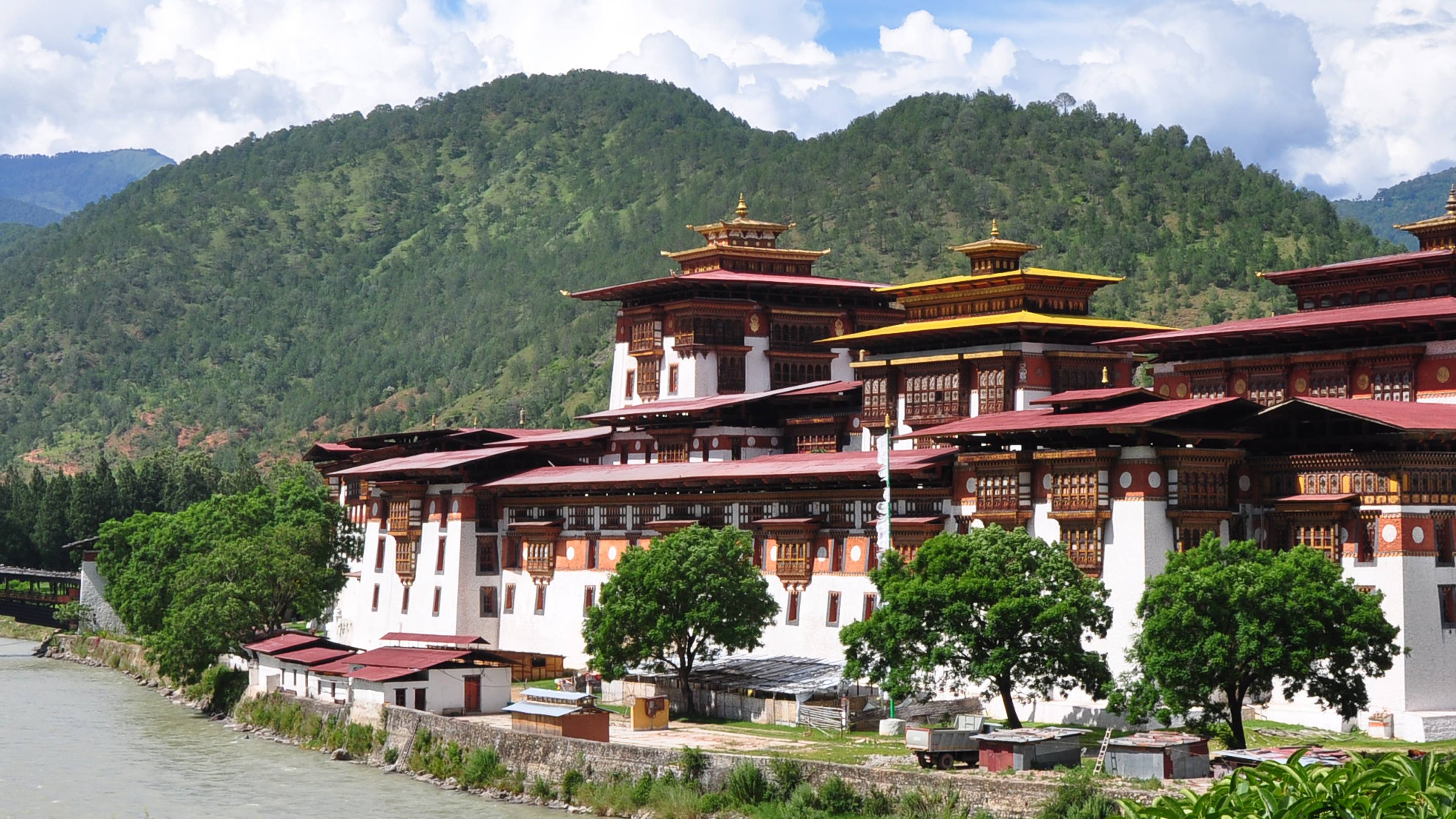

Travel in Bhutan
Right at the foot of the Himalayas, Bhutan, a country immune to the passing of time, is opening its doors to its extraordinary landscapes and architectural wonders. Thimphu, perhaps the only capital city in the world to not have traffic lights, is the spiritual centre of the country with its numerous Buddhist sites. It’s impossible not to fall under the charm of this long-forgotten region. Situated between India and Tibet, Bhutan is gradually emerging from centuries of isolation. Mass tourism does not exist here, and the natural and architectural sites have been incredibly well preserved. You will discover this unique destination through the beauty of its untouched landscapes and the warmth and kindness of its people. Adventure and a complete change of scenery are the essence of every stay in Bhutan, so be prepared for an amazing experience in one of the most secret countries in the world.

Guide to travelling in Bhutan
Taking a holiday to Bhutan is a great way to see a relatively-undiscovered destination filled with jaw-dropping monasteries, landscapes, valleys, and mountains. Nestled between China and India and flanked by Nepal and Bangladesh, Bhutan is a landlocked gem, with aspects of its surrounding cultures visible alongside its own unique national identity. Its location means that the entire country is covered with staggeringly mountainous scenery, making for a visually unforgettable trip. Active travellers, honeymooners or families; every visitor is sure to have an unforgettable trip in this fascinating, unusual and devastatingly-beautiful location.
Bhutan’s number of activities can be overwhelming for visitors organising their own tours, so anyone planning a holiday there should benefit from the knowledge of a local Evaneos expert based on-the-ground. A guided tour (as well as being necessary to gain entry) is essential to ensure you cover all the best places to visit. Planning a trip to Bhutan with one of Evaneos’ local experts will give you the most useful insights for planning your perfect tour. Above all, they can be your 24/7 on-the-ground support for everything, whether you need a translator or simple tips on the best hiking routes. With so much to see and do in Bhutan, from photographing wildlife to delving into the world of meditation, a local agent is a sure-fire way to pinpoint what interests you most and to ensure that you don’t miss it.
Best things to see and do in Bhutan
What to see in Bhutan
As well as being blissfully tourist-free, most travellers are drawn to Bhutan for its dramatic mountain scenery and atmosphere of serenity and spirituality. When planning any holiday to Bhutan, the first thing to consider is how many areas you want to see in the time you have there. For the sake of helping you narrow down the sites to include on your itinerary, here’s a quick travel guide to the top highlights of Bhutan:
- Tiger's Nest Monastery: the Tiger’s Nest Monastery, otherwise known as Paro Taktsang, is by far one of Bhutan’s most attractive sites for tourists from all over the world. Perched at a dizzying nine-hundred metres up the mountainside, not only is this destination thrilling but it is also an opportunity to see some of the country’s best views. For the more ambitious traveller, the hike to The Tiger’s Nest is an incredibly rewarding route and will only intensify the sense of awe that you will feel at the top. Located just ten kilometres North of Paro, The Tiger’s Nest is in the perfect detour from a convenient and comfortable stay in this beautiful nearby town.
- Dzongs and temples: religious sites nestle into the mountains and the incredible scenery in Bhutan, meaning that historical attractions that can be found here are unlike those of any other country. Start off with a visit to Paro Taktsang, a mountainside monastery that is sure to leave you in awe. Next, Punakha Dong, a palace and fortress overlooking a river, before a stop off at Tashichho Dzong to see the shrines and breathtaking flower garden. Chorten Kora is also well worth a visit and at this stupa, located next to the Kulong Chu River in Trashiyangtse, from where you can see incredible views as well as the blooming rhododendrons that Bhutan is famous for.
- Bhutanese villages: there’s no better way to get a sense of true Bhutanese culture than to visit some of its smaller towns and villages. Here you can see daily life in full swing, visiting marketplaces, monuments and favourite local spots. Punakha, a town that runs along a bank of the Puna Tsang Chu River, is home to a famous fortress and is the perfect place to explore for a day or two during your trip. Visitors shouldn’t miss out on a trip to Lhuntse where they can admire Bhutanese architecture as well as plenty of monasteries. Khuruthang is another unmissable spot, where you can wander narrow streets filled with traditional buildings and sample delicious food whilst taking some time to explore Bhutan’s off-the-beaten-track identity. For some history and culture, why not visit the National Museum of Bhutan? Located in a 17th century watchtower in the town of Paro, this incredible building holds artefacts that tell the story of Bhutan’s fascinating history.
- National parks: with Bhutan’s unbeatable natural scenery, landscapes, flora and fauna, it’s no wonder that the National Parks here are among some of the best in the world. Jigme Dorji National Park is the perfect choice for hikers, who can roam over the protected mountainous terrain and feel like the only people in the world. Bomdeling Wildlife Sanctuary is an obvious choice for travellers looking to get a closer look at Bhutan’s animal species ,and seeing wildlife such as the native tiger in such a beautiful backdrop is bound to be one of the highlights of any trip. Phrumsengla National Park is well-suited to the more casual visitor, who isn’t so keen on hardcore trekking or hiking. Here, you can wander the beautiful scenery interspersed with little temples and structures, making it a fascinating day out. Finally, it may not be a national park as such but Chele La is another highlight of the great Bhutanese outdoors. Here you can explore an overwhelmingly-picturesque mountain pass, complete with forests, waterfalls and even grazing yaks, all perfectly capturing the essence of Bhutanese nature.
- Tango Buddhist University: any trip to Bhutan would be incomplete without a visit to Tango Buddhist University and Monastery to see one of Bhutan’s most important religious sites. Located nearby to Cheri Mountain and the capital city of Thimphu, this is one of the places that monks go to train for an eight to nine year programme and you can visit to see what their day to day life is like. After a picturesque drive to the valley, you can hike up to the monastery which will take around two hours and is the perfect way to enjoy the views over the valley. Visit during the end of June though to July to see the Yarney festival, when monks undertake a month and a half of special rituals and practices once a year.
What to do in Bhutan
Bhutan's rugged terrains mean it's not exactly a destination for the fainthearted. Relaxation is definitely on the cards for those looking for a secluded getaway, but most travellers plan a trip there based on outdoor experiences. With such an abundance of adventure activities and cultural excursions on offer it can be hard to know where to start, so we’ll kick off with some of the most popular things to do in Bhutan, as requested by Evaneos’ travellers:
- Go hiking or trekking: Bhutan's national parks are perfect for trekking and hiking tours, whether you’re a seasoned pro or a relaxed explorer. Royal Manas National Park is one of the best examples, boasting typical Bhutanese scenery that's become a staple of postcards and images characterising the country's appeal for active travellers. Jigme Dorji National Park is another great choice and is perfect for those looking to get away from other tourists, since it is more remote than many others. Laya is an interesting place to hike, since you will see the free-ranging yak as you take in the breath-taking surroundings. Phajoding should be the top choice for tourists wanting to camp, with specially-chosen spots located around the area.
- Go bird-watching: a wildlife tour of some sort is a must during any trip to Bhutan, and a trained guide will be able to help you spot the country's rarest species such as the black-necked crane, which can be seen all over the county’s parks and reserves. Motithang Takin Preserve is a wildlife preserve dedicated to Bhutan’s national animal, the Takin, and should definitely make it onto your list of places to see in Bhutan since it boasts some rare bird species that can’t be seen elsewhere. Gelephu is known for its bird-watching opportunities and is a hot-spot for budding photographers. Tingtibi is another well-known spot that bird-watching enthusiasts should add to their lists of places to visit during their time here.
- Meet the local people: hearing about the stories and lives of Bhutan’s local people will give you a fascinating insight into life here as you learn about the Bhutanese culture. Visit one of the country’s smaller towns or stay with a local family in a village off-the-beaten-track. Khoma, a settlement in the north of Bhutan is the perfect place, with beautiful surroundings and welcoming people, you’ll get a chance to feel like you are on a break from the stress of everyday life. Samdrup Jongkhar and Haa are just two more great choices for towns and villages where you can get to know the locals. Khaling is a town known for its weaving and so is the perfect place to visit to learn a traditional Bhutanese craft whilst getting some genuine interaction with local Bhutanese life.
- Try your hand at archery: as the national sport of Bhutan, it’s no surprise that the locals have such a passion for the bow and arrow. You'll inevitably get a taste of this sport during your time in Bhutan, since every village, town, and city has a space dedicated to the practice of archery. It is not uncommon to come across a noisy tournament on your travels. After seeing it everywhere, it’s only right that you might want to have a go yourself, and the best places to do this are Thimphu or Paro, where you can find numerous opportunities to end your trip as an archery expert.
- Attend a festival: festivals are a huge part of Bhutanese culture and one that is always a favourite with visiting tourists. The country hosts some major, nationwide festivals at various points throughout the year. Jambay Lhakhang Festival is a great place to see traditional Bhutanese dancing, for example, including a midnight naked dance, as well as a fire blessing ceremony. Each district also has its own festival, each of which are called tshechus. Some of the best are the Thimphu Tshechu, one of the largest in Bhutan, and the Paro Tshechu, one of the most popular spring festivals.
For the best tips, information, and inspiration to plan your holiday to Bhutan, ask the experts: Evaneos' hand-picked local travel agencies based there. As well as providing unparalleled local knowledge including access to hidden gems and advice on how to avoid tourist-traps, they'll organise the trip of a lifetime for you based around your needs and interests.
Best time to visit Bhutan
The best time to visit Bhutan depends on what you would like to do and see during your holiday. High season is usually between March and April, when the weather is dry and the rhododendrons are in full bloom. Expect to see more other tourists than usual and to have to book further in advance to secure accommodation and activities. October to November is another great option if you’re still deciding when to visit Bhutan. During this period the weather is mild and perfect for trekking, with clear views. From October to February, birdwatchers and wildlife enthusiasts travel to Bhutan to see the famous black-necked cranes. One of the best festivals in Bhutan revolves around these cranes and takes place in November. June to September is generally monsoon season, with rainfall every day but only for an hour or two. Should you choose to travel during this low season, the humidity and temperatures are higher but the rain doesn’t have to effect your trip, as long as you’re prepared for it and as a bonus, prices are often much cheaper.
Tips and advice for travelling to Bhutan
Visa regulations for Bhutan
A visa is required for almost all foreign visitors to Bhutan. Bhutan visas aren’t too hard to obtain but must be organised in advance. They also require that tourists book a tour in order to enter the country, since independent tourism is prohibited. For more information on specific circumstances we recommend that you check out the visa regulations online for your country of origin to make sure well-prepared for your trip.
Vaccinations for Bhutan
As well as topping up your regular vaccinations before your trip to Bhutan, you will need to make sure that you have the following injections: Hepatitis A and B, Tetanus, Typhoid, and Rabies. Those travelling to specific areas or visiting more remote locations may also be advised by a GP to get injections against Cholera and Japanese Encephalitis.
When to go in Bhutan?
Traveller reviews of their trip to Bhutan
How to get in Bhutan?
The transport to get in Bhutan is not included in the price of your trip. You can easily book it at any time through one of our partners.

